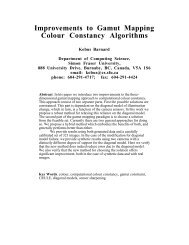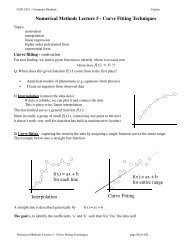1 Introduction
1 Introduction
1 Introduction
- No tags were found...
Create successful ePaper yourself
Turn your PDF publications into a flip-book with our unique Google optimized e-Paper software.
1.5. Decision Theory 45application). If we know the posterior probabilities, we can trivially revise theminimum risk decision criterion by modifying (1.81) appropriately. If we haveonly a discriminant function, then any change to the loss matrix would requirethat we return to the training data and solve the classification problem afresh.Reject option. Posterior probabilities allow us to determine a rejection criterion thatwill minimize the misclassification rate, or more generally the expected loss,for a given fraction of rejected data points.Compensating for class priors. Consider our medical X-ray problem again, andsuppose that we have collected a large number of X-ray images from the generalpopulation for use as training data in order to build an automated screeningsystem. Because cancer is rare amongst the general population, we might findthat, say, only 1 in every 1,000 examples corresponds to the presence of cancer.If we used such a data set to train an adaptive model, we could run intosevere difficulties due to the small proportion of the cancer class. For instance,a classifier that assigned every point to the normal class would already achieve99.9% accuracy and it would be difficult to avoid this trivial solution. Also,even a large data set will contain very few examples of X-ray images correspondingto cancer, and so the learning algorithm will not be exposed to abroad range of examples of such images and hence is not likely to generalizewell. A balanced data set in which we have selected equal numbers of examplesfrom each of the classes would allow us to find a more accurate model.However, we then have to compensate for the effects of our modifications tothe training data. Suppose we have used such a modified data set and foundmodels for the posterior probabilities. From Bayes’ theorem (1.82), we see thatthe posterior probabilities are proportional to the prior probabilities, which wecan interpret as the fractions of points in each class. We can therefore simplytake the posterior probabilities obtained from our artificially balanced data setand first divide by the class fractions in that data set and then multiply by theclass fractions in the population to which we wish to apply the model. Finally,we need to normalize to ensure that the new posterior probabilities sum to one.Note that this procedure cannot be applied if we have learned a discriminantfunction directly instead of determining posterior probabilities.Combining models. For complex applications, we may wish to break the probleminto a number of smaller subproblems each of which can be tackled by a separatemodule. For example, in our hypothetical medical diagnosis problem,we may have information available from, say, blood tests as well as X-ray images.Rather than combine all of this heterogeneous information into one hugeinput space, it may be more effective to build one system to interpret the X-ray images and a different one to interpret the blood data. As long as each ofthe two models gives posterior probabilities for the classes, we can combinethe outputs systematically using the rules of probability. One simple way todo this is to assume that, for each class separately, the distributions of inputsfor the X-ray images, denoted by x I , and the blood data, denoted by x B ,are





